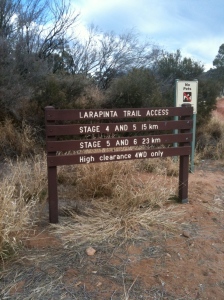 I’m about to go out and do some solo hiking along the Larapinta Trail.
I’m about to go out and do some solo hiking along the Larapinta Trail.
Actually, I’m hoping it stops raining and warms up enough to let me go, because right now, it’s FREEZING in Central Australia.
As I’m by myself (yes, that’s right: a woman, walking alone on the Trail), one of the things I’ll be taking with me is a Personal Locator Beacon.
 Personal Locator Beacons or PLBs are little life saving devices that all walkers, outback visitors and hikers should have.
Personal Locator Beacons or PLBs are little life saving devices that all walkers, outback visitors and hikers should have.
How a PLB Works
I’ll let you know that I had a vague idea how a PLB worked:
by broadcasting a signal to a satellite which let authorities know where you were.
broadcasting a signal to a satellite which let authorities know where you were.
A couple of weeks ago, the people who monitor the PLB alerts (the Australian Maritime Safety Authority) were here in Alice Springs. They were able to fill in some of the details for me – and alert me to the fact that it’s not a perfect service!
When turned on, the PLB broadcasts a signal that is picked up by satellites orbiting the Earth.
This signal is then relayed to the Australian Maritime Safety Authority (AMSA) thru a ground station who will contact the most relevant authorities to help in any search and recovery.
Sometimes, this signal is weak and difficult to get a fix on. More on this later.
The people who are monitoring often have to wait until the satellite makes another pass over the area. This can take up to 45 minutes.
Once an approximate location has been determined, the relevant authorities are called in.
For walkers like me, in the Outback, this will be rangers on foot or NT Emergency Services via helicopter.
The rangers or chopper go to the coordinates the personal locator beacon broadcasts ( or uses radio direction finding to home in on the beacon ). More often than not, this will be an approximate location.
They can then search for the walker and rescue them.
Types of Personal Locator BEacons
This is where is gets really interesting and I have to tell you, I learned a lot! I’d always thought that PLBs were pretty much the same. However, that’s not the case.


I discovered that there are 2 differing types. Your successful rescue (in the case of an emergency) could depend upon you selecting the right PLB:
- One type simply broadcasts a signal
- The other sends a signal AND your GPS co-ordinates
Remember how I told you above that getting an accurate position on a PLB signal can be difficult?
The first kind of PLB (the one that only sends a signal) means that the authorities will take the longer to figure out just where the signal is coming from.
This is because at least 2 passes overhead by the satellite are required to identify the location.
The PLB with the GPS fitted provides a nearly immediate set of co-oordinates which will enable a rescue to be kicked off immediately.


So if you’re truly in difficulty or have life-threatening issues I know which one I might select.
Trust me, the marginally higher cost of GPS-enabled PLB could be the honest to goodness difference between life and death. I know which one I’d rather have!
TIPS FOR USING A PERSONAL LOCATOR BEACON
It’s very important to remember that a PLB is a final resort.
Your primary emergency should be by phone, radio or other direct communication if available. Direct communication will always end up in a quicker and more acceptable reply as you’ll be able to talk with emergency services.
Only utilize a PLB if you are unable to speak straight to emergency services and important help is needed.
What do you need to know about using a PLB so you can get the best signal out?
- Before using your PLB, move to an open area away from trees and scrub
- Try to get up as high as possible
- Make sure you’ve got a clear view of the maximum amount of the sky that you can get
The bad news is, there are some instances when a PLB either won’t work or you’re going to have to wait a very long time before rescue:
- Thick cloud cover – sometimes interferes with signals
- If you’re in a gorge or canyon – the signal just won’t get out clearly
- Stormy weather – Lightning can make it tricky to get a precise position and delay rescue.
- Also remember that stormy weather might delay ground crews or rescue by chopper
- Night – Satellites will pick up the PLB signal at night, but it may be the day after before a copter or the rangers can get in to find you
So, in talking to the people at the AMSA, I’ll tell you I did indeed learn a lot.
Hopefully, I won’t need to use my PLB (it’s one of the ones WITHOUT the GPS!) when I’m off hiking over the next few days.




















